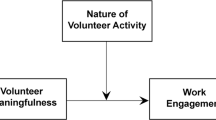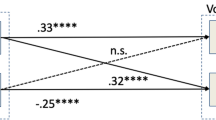Abstract
In nonprofit organizations, hybrid activities that straddle both paid work and volunteering have been documented. However, conceptualization of these hybrid activities is missing. This article conceptualizes one kind hybrid activity—“staff volunteering” (SV) in which self-selected, paid nonprofit employees, motivated by volunteerism, willingly volunteer to perform work that is perceived to be unpaid by the employee. SV enriches our understanding of volunteerism and the nature of nonprofit work by conceptualizing the phenomenon of paid SV at work. SV informs nonprofit managers about the staff’s work motivation and both the benefits and dangers of relying on SV. The conceptualization also provokes us to rethink the role and status of NPOs within the framework of the New Public Management.
Résumé
Dans les associations à but non lucratif, si les activités hybrides qui combinent travail rémunéré et bénévolat ont bien été documentées, elles n’ont en revanche pas été conceptualisées. Cet article conceptualise un type d’activité : le « bénévolat des employés » , pour lequel des salariés d’organisations à but non lucratif, motivés par le bénévolat, se portent volontaires pour travailler d’une manière perçue comme non rémunérée du point de vue de l’employé. Le bénévolat des employés nous permet de mieux comprendre le bénévolat et la nature du travail sans but lucratif en conceptualisant le phénomène du bénévolat des salariés à leur travail. Cette pratique renseigne les dirigeants des organisations à but non lucratif sur la motivation des employés, mais y avoir recours comporte des avantages et des risques. La conceptualisation nous incite également à repenser le rôle et le statut des associations à but non lucratif dans le cadre de la nouvelle gestion publique.
Zusammenfassung
In Nonprofit-Organisationen werden hybride Aktivitäten dokumentiert, die sowohl bezahlte als auch ehrenamtliche Arbeit umfassen. Allerdings fehlt eine Konzeptualisierung dieser hybriden Aktivitäten. Der vorliegende Beitrag konzeptualisiert eine Art hybrider Aktivität - das „ehrenamtliche Engagement von Mitarbeitern“, bei dem selbstgewählte, bezahlte Mitarbeiter gemeinnütziger Organisationen aufgrund ihrer Motivation zum ehrenamtlichen Engagement freiwillig ehrenamtliche Arbeit leisten, die von ihnen als unbezahlt betrachtet wird. Das ehrenamtliche Engagement von Mitarbeitern bereichert unser Verständnis der ehrenamtlichen Tätigkeit und der gemeinnützigen Arbeit an sich, indem das Phänomen, dass bezahlte Mitarbeiter auf der Arbeit ehrenamtliche Tätigkeiten ausüben, konzeptualisiert wird. Das ehrenamtliche Engagement von Mitarbeitern gibt Nonprofit-Managern Aufschluss über die Arbeitsmotivation der Mitarbeiter sowie über die einhergehenden Vorteile und Risiken, wenn man sich auf das ehrenamtliche Engagement der Mitarbeiter verlässt. Die Konzeptualisierung bewirkt zudem, dass wir die Rolle und Stellung der Nonprofit-Organisationen im Rahmen des neuen Steuerungsmodells (New Public Management) überdenken.
Resumen
En las organizaciones sin ánimo de lucro, se han documentado las actividades híbridas que abarcan tanto el trabajo pagado como el voluntariado. Sin embargo, falta la conceptualización de estas actividades híbridas. El presente artículo conceptualiza una actividad híbrida de un tipo - el “voluntariado del personal” (SV, del inglés staff volunteering), en el que los empleados autoseleccionados, no pagados de las organizaciones sin ánimo de lucro, motivados por el voluntariado, se ofrecen voluntarios con buena disposición a llevar a cabo un trabajo que es percibido por el empleado como no pagado. SV enriquece nuestra comprensión del voluntariado y la naturaleza del trabajo sin ánimo de lucro mediante la conceptualización del fenómeno de voluntariado del personal pagado en el trabajo. SV informa a los directores de las organizaciones sin ánimo de lucro sobre la motivación laboral del personal, así como también de los beneficios y los peligros de confiar en el SV. La conceptualización también nos obliga a repensar el papel y la situación de las organizaciones sin ánimo de lucro (NPO) dentro del marco de la Nueva Gestión Pública.
摘要
在非营利性组织中,我们可以看到关于同时包括了有偿工作与志愿服务的混合性活动的记录。然而,关于这些混合性活动的概念化记录尚属空白。本文为一种混合性活动——“员工志愿服务”(staff volunteering, SV)——进行概念化。在这种“员工志愿服务”中,自我选择的、接受报酬的非营利性组织员工,在志愿精神的驱动下,自愿参加无偿的志愿服务。通过对接受报酬员工的志愿服务现象进行概念化,SV丰富了我们对志愿精神和志愿服务以及非营利性工作的性质的理解。SV概念使得非营利性组织的管理者更好地理解员工的工作动机以及依靠SV的益处与风险。此概念化过程还促使我们在新公共管理框架里对非营利性组织的角色与地位进行反思。
ملخص
في المنظمات الغير ربحية، تم توثيق الأنشطة المختلطة التي تمتد على حد سواء للعمل بأجر والعمل التطوعي. مع ذلك، تصور هذه الأنشطة المختلطة مفقود. هذا البحث يصورمفهوم نوع واحد من النشاط المختلط -”موظفي العمل التطوعي “ (SV) الذين يتم اختيارهم ذاتيا˝٬ موظفين بأجر لا يسعى إلى الربح، بدافع التطوع، متطوع عن طيب خاطر لأداء العمل الذي ينظر إليه على أنه غير مدفوع الأجرمن قبل الموظف. موظفي العمل التطوعي (SV) يحسن فهمنا للعمل التطوعي وطبيعة العمل الغير ربحي من خلال تصور ظاهرة تطوع الموظفين في العمل. موظفي العمل التطوعي (SV) يقومون بإعلام المديرين الذين لا يسعون للربح حول دافع عمل الموظفين على حد سواء وفوائد ومخاطرالإعتماد على موظفي العمل التطوعي(SV). التصور يحثنا أيضا˝ لإعادة التفكير في دور ومكانة المنظمات الغير ربحية في إطارمن الإدارة العامة الجديدة.

Similar content being viewed by others
References
Alexander, J., Nank, R., & Stivers, C. (1999). Implications of welfare reform: Do nonprofit survival strategies threat civil society? Nonprofit and Voluntary Sector Quarterly, 28, 452–475.
Aronson, J., & Neysmith, S. M. (1996). “You’re not just in there to do the work”. Depersonalizing policies and the exploitation of home care workers’ labor. Gender & Society, 10(1), 59–77.
Backman, E., & Smith, S. R. (2000). Healthy organizations, unhealthy communities? Nonprofit Management and Leadership, 10(4), 355–373.
Baines, D. (2004a). Caring for nothing: Work Organization and Unwaged Labour in social services. Work, Employment & Society, 18(2), 267–295.
Baines, D. (2004b). Seven kinds of work—only one paid: Raced, gendered and restructured work in social services. Atlantis, 28(2), 19–28.
Baines, D. (2006). Staying with people who slap us around: Gender, juggling responsibilities and violence in paid (and unpaid) care work. Gender, Work and Organization, 13(2), 129–151.
Brower, R. S., & Jeong, H.-S. (2008). Grounded analysis: Going beyond description to derive theory from qualitative data. In G. J. Miller & K. Yang (Eds.), Handbook of research methods for public administration. London: Taylor & Francis.
Cnaan, R. A., Handy, F., & Wadsworth, M. (1996). Defining who is a volunteer: Conceptual and empirical considerations. Nonprofit and Voluntary Sector Quarterly, 25(3), 364–383.
Conway, N., & Briner, R. B. (2005). Understanding psychological contracts at work: A critical evaluation of theory and research. Oxford: Oxford University Press.
Eikenberry, A. M., & Kluver, J. D. (2004). The marketization of the nonprofit sector: Civil society at risk? Public Administration Review, 64(2), 132–140.
Finch, J., & Groves, D. (1983). A labor of love. London: Routledge & Kegan Paul.
Frank, R. (1996). What price the high moral ground? Southern Economic Journal, 61, 1–17.
Freeman, R. B. (1997). Working for nothing: The supply of volunteer labor. Journal of Labor Economics, 15, s140–s166.
Gazley, B., & Brudney, J. L. (2007). The purpose (and perils) of government-nonprofit partnership. Nonprofit and Voluntary Sector Quarterly, 36, 389–415.
Hall, M. (2009). NPOs in Canada. In V. Murray (Ed.), The management of nonprofit and charitable organizations in Canada (pp. 25–54). LexisNexis Butterworths.
Handy, F., & Katz, E. (1998). The wage differential between nonprofit institutions and corporations: Getting more by paying less? Journal of Comparative Economics, 26(2), 246–261.
Hansmann, H. B. (1980). The role of nonprofit enterprise. Yale Law Journal, 89, 835–901.
Harris, P. (2012) How much money are we earning? The average Canadian wages right now. Retrieved on January 23 at http://www.workopolis.com/content/advice/article/1821-how-much-money-are-we-earning-the-average-canadian-wages-right-now.
Hood, C. (1995). The “New Public Management” in the 1980s: Variations on a theme. Accounting, Organizations and Society, 20(2), 93–109.
Houston, D. J. (2006). “Walking the Walk” of public service motivation: Public employees and charitable gifts of time, blood, and money. Journal of Public Administration Research and Theory, 16(1), 67–86.
Hustinx, L., Cnaan, R. A., & Handy, F. (2010). Navigating theories of volunteering: A hybrid map for a complex phenomenon. Journal for the Theory of Social Behavior, 40(4), 411–434.
James, N. (1992). Care = organization + physical labor + emotional labor. Sociology of Health & Illness, 14, 488–509.
Kaplan Daniels, A. (1987). Invisible work. Social Problems, 34, 403–415.
Kettl, D. F. (1997). The global revolution in public management: Driving themes, missing links. Journal of Policy Analysis and Management, 16(3), 446–462.
Knutsen, W. L. (2012). Value as a self-sustaining mechanism: Why Some Nonprofit Organizations are Different From and Similar to Private and Public Organizations. Nonprofit and Voluntary Sector Quarterly,. doi:10.1177/0899764012457244.
Lee, Y. (2012). Behavioral Implications of Public Service Motivation: Volunteering by Public and Nonprofit Employees. The American Review of Public Administration, 42(1), 104–121.
Leete, L. (2006). Work in Nonprofit Sector. In W. W. Powell & R. Steinberg (Eds.), The Non-Profit Sector: A Research Handbook (pp. 159–179). New Haven & London: Yale University Press.
Locke, K. (2001). Grounded theory in management research. London: Sage Publications.
McCracken, G. (1988). The long interview. Newbury Park, CA: Sage.
Milward, H. B., & Provan, K. G. (2000). Governing the hollow state. Journal of Public Administration Research and Theory, 10(2), 359–379.
Moore, M. H. (2000). Managing for value: Organizational strategy in for-profit, nonprofit, and governmental organizations. Nonprofit and Voluntary Sector Quarterly, 29(suppl 1), 183–208.
Morrison, E. W., & Robinson, S. L. (1997). When employees feel betrayed: A model of how psychological contract violation develops. Academy of Management Review, 22, 226–256.
Ontario Ministry of Health, Bill 173. (1994) An act respecting long-term care, Queen’s Printer.
Organ, D. W. (1988). Organizational citizenship behavior: The good soldier syndrome. Lexington: Lexington Books.
Osborne, D., & Gaebler, T. (1992). Reinventing government: How the entrepreneurial spirit is transforming government. Reading, MA: Addison-Wesley.
Preston, A. E. (1989). The nonprofit worker in a for-profit world. Journal of Labor Economics, 7, 438–463.
Richmond, T., & Shields, J. (2004). NGO restructuring: constrains and consequences. Canadian Review of Social Policy, 53, 53–67.
Robinson, S. L., & Morrison, E. W. (1995). Psychological contracts and OCB: The effect of unfulfilled obligations on civic virtue behavior. Journal of Organizational Behavior, 16, 289–298.
Robinson, S. L., & Rousseau, D. M. (1994). Violating the psychological contract: Not the exception but the norm. Journal of Organizational Behavior, 15, 245–259.
Rose-Ackerman, S. (1996). Altruism, nonprofits, and economic theory. Journal of Economic Literature, 34, 701–728.
Rousseau, D. M. (1989). Psychological and implied contracts in organizations. Employee Responsibilities and Rights Journal, 2(2), 121–139.
Rousseau, D. M. (1995). Psychological contracts in organizations: understanding written and unwritten agreements. Thousand Oaks: Sage.
Skinner, M. W., & Rosenberg, M. W. (2005). Co-opting voluntarism? Exploring the implications of long-term care reform for the nonprofit sector in Ontario. Environment and Planning C, 23, 101–121.
Snyder, M., & Omoto, A. M. (2008). Volunteerism: Social issues perspectives and social policy implications. Social Issues and Policy Review, 2(1), 1–36.
Strauss, A. L. (1991). Qualitative analysis for social scientists. Cambridge: Cambridge University Press.
Strauss, A., & Corbin, J. (1998). Basics of qualitative research: Techniques and procedures for developing grounded theory. Thousand Oaks: Sage Publications.
Wanous, J. P. (1977). Organizational entry: Newcomers moving from outside to inside. Psychological Bulletin, 84, 601–618.
Wilson, J. (2000). Volunteering. Annual Review of Sociology, 26, 215–240.
Wilson, J. (2012). Volunteerism research: A review essay. Nonprofit and Voluntary Sector Quarterly, 41(2), 176–212.
Zhao, H. A. O., Wayne, S. J., Glibkowski, B. C., & Bravo, J. (2007). The impact of psychological contract breach on work-related outcomes: A meta-analysis. Personnel Psychology, 60(3), 647–680.
Author information
Authors and Affiliations
Corresponding author
Rights and permissions
About this article
Cite this article
Knutsen, W.L., Chan, Y. The Phenomenon of Staff Volunteering: How Far Can You Stretch the Psychological Contract in a Nonprofit Organization?. Voluntas 26, 962–983 (2015). https://doi.org/10.1007/s11266-014-9476-8
Published:
Issue Date:
DOI: https://doi.org/10.1007/s11266-014-9476-8




